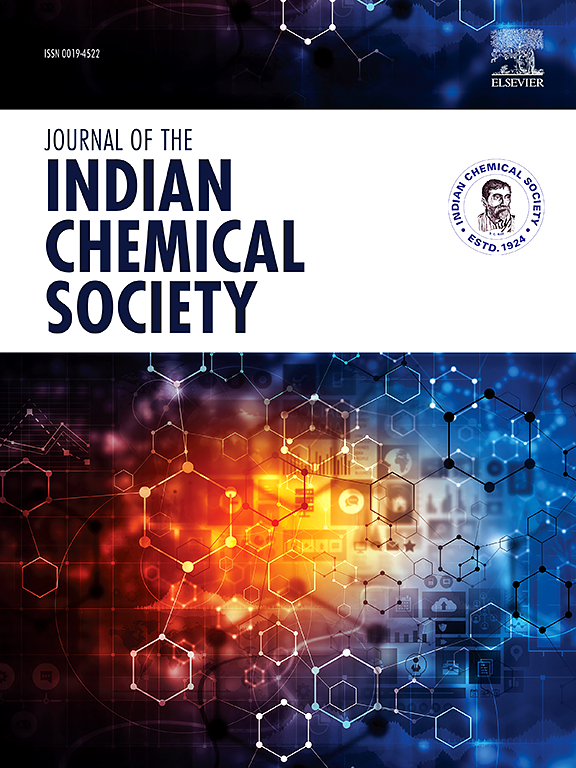Synthesis, characterization and numerical simulations of hybrid nanofluid flow under electromagnetic fields with Arrhenius activation energy
IF 3.2
4区 化学
Q2 CHEMISTRY, MULTIDISCIPLINARY
引用次数: 0
Abstract
This study presents the synthesis, experimental characterization and numerical investigation of hybrid nanofluid (HNF) flow under the influence of electromagnetic fields and activation energy. HNFs containing carbon nano-onions and titanium dioxide nanoparticles in a base fluid were synthesized, and their structural, morphological, and thermal properties were examined using FESEM, FTIR, and UV–Vis spectroscopy. The enhanced thermophysical properties of the synthesized HNFs were then incorporated into a mathematical model describing stagnation-point flow over a porous stretching surface. The model accounts for the effects of electromagnetic fields, Joule heating, activation energy, and variable viscosity. A similarity transformation was applied to reduce the governing partial differential equations to a system of nonlinear ordinary differential equations, which were solved numerically using the BVP4C method. The influence of key parameters on engineering quantities and flow profiles was thoroughly analysed. The findings from the FESEM assessment affirm that the nanoparticles have a consistent size distribution from around 10 to 50 nm, revealing excellent dispersion in water. The FTIR analysis verifies the presence of TiO2 within the composite material, indicated by characteristic peaks linked to OH, C![]() O, C–N stretching, and Ti–O modes. The absorbance peak for each sample is noted around 330–350 nm, implying broader bandgap values. Moreover, the study reveals that an increase in radiation results in a 7.3 % decline in the heat transfer rate, whereas the mass transfer rate improves by 3.57 % in HNF due to a higher reaction rate. The skin friction in HNF diminishes by 3.12 % because of an enhanced electric field, whereas it escalates by 5.95 % with an increase in the variable viscosity factor.
O, C–N stretching, and Ti–O modes. The absorbance peak for each sample is noted around 330–350 nm, implying broader bandgap values. Moreover, the study reveals that an increase in radiation results in a 7.3 % decline in the heat transfer rate, whereas the mass transfer rate improves by 3.57 % in HNF due to a higher reaction rate. The skin friction in HNF diminishes by 3.12 % because of an enhanced electric field, whereas it escalates by 5.95 % with an increase in the variable viscosity factor.

具有阿伦尼乌斯活化能电磁场下混合纳米流体的合成、表征及数值模拟
本文研究了电磁场和活化能影响下混合纳米流体(HNF)流动的合成、实验表征和数值研究。在基液中合成了含有碳纳米洋葱和二氧化钛纳米颗粒的HNFs,并使用FESEM、FTIR和UV-Vis光谱对其结构、形态和热性能进行了研究。然后将合成的hnf的增强热物理性质纳入描述多孔拉伸表面上的停滞点流动的数学模型中。该模型考虑了电磁场、焦耳加热、活化能和变粘度的影响。采用相似变换将控制偏微分方程简化为非线性常微分方程组,并采用BVP4C方法进行数值求解。深入分析了关键参数对工程量和流型的影响。FESEM评估的结果证实,纳米颗粒在10到50纳米之间具有一致的尺寸分布,在水中具有良好的分散性。FTIR分析证实了复合材料中TiO2的存在,通过与OH, CO, C-N拉伸和Ti-O模式相关的特征峰表明。每个样品的吸光度峰在330-350 nm附近,这意味着更宽的带隙值。此外,研究表明,辐射的增加导致传热率下降7.3%,而在HNF中,由于反应速率的提高,传质率提高了3.57%。由于电场的增强,HNF的表面摩擦减少了3.12%,而随着可变粘度系数的增加,表面摩擦增加了5.95%。
本文章由计算机程序翻译,如有差异,请以英文原文为准。
求助全文
约1分钟内获得全文
求助全文
来源期刊
CiteScore
3.50
自引率
7.70%
发文量
492
审稿时长
3-8 weeks
期刊介绍:
The Journal of the Indian Chemical Society publishes original, fundamental, theorical, experimental research work of highest quality in all areas of chemistry, biochemistry, medicinal chemistry, electrochemistry, agrochemistry, chemical engineering and technology, food chemistry, environmental chemistry, etc.

 求助内容:
求助内容: 应助结果提醒方式:
应助结果提醒方式:


